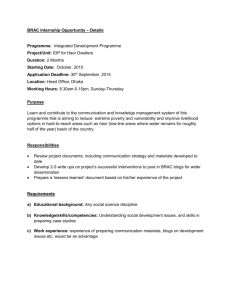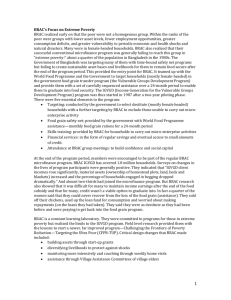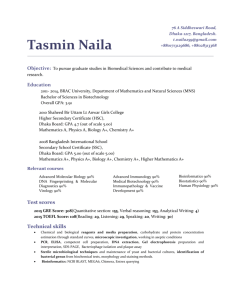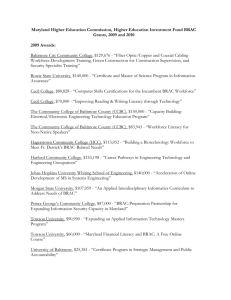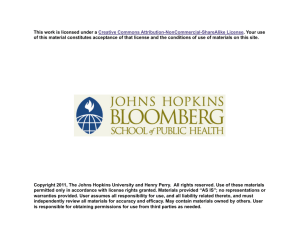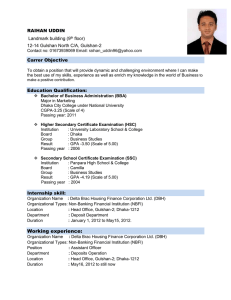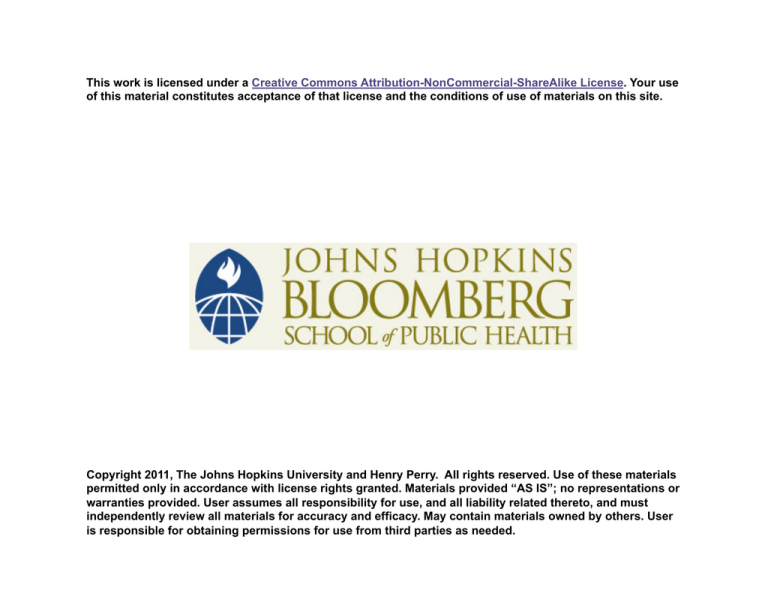
This work is licensed under a Creative Commons Attribution-NonCommercial-ShareAlike License. Your use
of this material constitutes acceptance of that license and the conditions of use of materials on this site.
Copyright 2011, The Johns Hopkins University and Henry Perry. All rights reserved. Use of these materials
permitted only in accordance with license rights granted. Materials provided “AS IS”; no representations or
warranties provided. User assumes all responsibility for use, and all liability related thereto, and must
independently review all materials for accuracy and efficacy. May contain materials owned by others. User
is responsible for obtaining permissions for use from third parties as needed.
Section B
Scaling-Up and Sustainability of Community-Based
Primary Health Care: The BRAC Experience
With the assistance of Faruque Ahmed, Director BRAC Health Program
BRAC at a Glance
At work since 1972
- Bangladesh Rural Advancement Committee is now Building
Resources Across Communities
Reaching beyond Bangladesh to Afghanistan, Sri Lanka, Pakistan,
Tanzania, Uganda, Southern Sudan
Annual budget in 2007: US$ 495 million
- 77% self-generated
Reaching 110 million people in all 64 districts in Bangladesh
More than 95,000 staff and 3,350 offices in Bangladesh
Largest NGO in world in terms of beneficiaries and staff
Core programs
- Economic development (including micro-finance)
- Education
- Health
- Social development
- Human rights
3
www.brac.net
4
BRAC Vision
Our vision is of a just, enlightened, healthy, and democratic world
free from hunger, poverty, environmental degradation and all forms
of exploitation
5
Learning from Early Mistakes
“Capture” of programs by local elites
Failure of doctors and paramedics to function effectively in the
villages
Doctor-run clinics were expensive and had little outreach
Refashioning of programs to serve the neediest people
6
Village Organizations
Village organizations are
pathways to BRAC’s
community work
- Micro-finance:
backbone for VOs
- Village organizations:
needed to support
Shasthya Shebikas
- Shasthya Shebikas:
provide essential
health care
Micro-finance
Village organizations
Shasthya Shebikas
Essential health care
7
Community Health Volunteers: Shasthya Shebikas
BRAC VO member
- Married
- Over 25 years of age
Delivers door-to-door preventive and
basic curative health
Average coverage: 250 households
Fills in the critical health human
resource gap
Shasthya Shebikas
Photo: Henry Perry
8
BRAC Village Organization
Photo: Henry Perry
9
Responsibilities of Shasthya Shebikas
Routine systematic home
visitation
Promote of health,
nutrition, and hygiene
Treat 10 common diseases
and sell essential drugs
Implement DOTS
Sell iodized salt, delivery
kits, condoms, pills, soap,
etc.
Social mobilization for NID
and vitamin A campaigns
Collect health information
and ensure timely referrals
Photo: Henry Perry
Shasthya Shebika providing DOTS
10
Heath For All in Bangladesh
11
Activities of Shasthya Shebikas with 150–200 Families
12
Activities of Shasthya Shebikas with 150–200 Families
13
Shasthya Shebika Scale-Up
Chart: Henry Perry. Data Source: BRAC.
14
An Overview of BRAC’s Global Operations
Country
Total number Year
of
program
beneficiaries established
Number of program staff
Part-time/nonFull-time
Total
salaried staff
56,740
126,607 183,347
Bangladesh
110,000,000
1982
Afghanistan
335,838
2002
3,808
0
3,808
Sri Lanka
40,701
2004
550
0
550
Tanzania
64,444
2006
355
0
355
Uganda
Southern
Sudan
Pakistan
48,405
2006
399
0
399
4,772
2006
44
0
44
4,772
2007
198
0
198
Indonesia
na
2008
na
na
na
Data Source: BRAC.
15
Oral Therapy Extension Program
13 million homes visited
“Perhaps the largest house-to-house” public health effort ever
undertaken (Jon Rohde)
16
Measurable Impacts of Shasthya Shebikas in TB Control
Tuberculosis (TB) control
- Treatment completion rate over 90%
- TB prevalence in BRAC areas half the rate in other areas
- Reference: Chowdhury et al., Lancet, 1997
17
Collection and Analysis of Sputum
Photos: Henry Perry
18
Shasthya Shebikas Link Vertical, Horizontal Approaches
The BRAC experience suggests that perhaps vertical and horizontal
approaches can be synergistic if there is a unifying agent at the
community level with appropriate:
- Training
- Supervision
- Logistical support
- Incentives to carry out her work
19
Getting the Right Balance of Responsibilities Is Critical
How to further improve and expand programs without overloading
such a community worker is now a key issue for BRAC
20
Emergence of PHC Systems
“The emphasis has to shift from showing immediate
results from single interventions to creating
integrated, long-term, sustainable health systems,
which can be built from a more selective primary
health-care start.”
—Walley et al., (2008). Lancet.
21
BRAC’s Contributions to PHC
BRAC is leading the way in this shift
BRAC is the world’s best example of implementation of the
principles of Alma Ata at scale
22
Impacts of Shasthya Shebikas in Child Health
BRAC’s programs reach two-thirds of the Bangladesh population
Universal child immunization achieved only in the BRAC areas in
1990s
Oral rehydration therapy: highest utilization rate in the world
Under-five mortality: Bangladesh one of only 19 of 68 high-mortality
countries on track to reach MDG 4
Sources: Chowdhury. (1995). Near Miracle in Bangladesh.
Chowdhury and Cash. (1996). A Simple Solution: Teaching Millions to Treat Diarrhea at Home
UNICEF, Countdown to 2015: Tracking Progress in Maternal, Newborn & Child Health, the 2008 Report.
23
Ingredients for Scale-Up
Logistical support
Supervision
Government cooperation
Remuneration strategy
24
Other Elements for Scale-Up and Sustainability
Vision
Leadership
Learning from mistakes/fostering “learning organization: mentality
Strong M&E system
- 5% of budget goes to research activities designed to improve
programs
Interdependence with, not dependence on, donors
- And willingness to detach from donors
25
F. H. Abed, President and Founder of BRAC
Photo Source: http://en.wikipedia.org/wiki/File:F-H-Abed-shadow.jpg. Creative Commons BY.
26
Other Elements for Scale-Up and Sustainability
Vision
Leadership
Learning from mistakes/fostering “learning organization: mentality
Strong M&E system
- 5% of budget goes to research activities designed to improve
programs
Interdependence with, not dependence on, donors
- And willingness to detach from donors
27
Critical Elements
Primacy of village-level workers
- Recruited from among their own community
- Compensated through resources mobilized in the community
- Responsible to that community and its members
28
Critical Elements
Orderly, objective, incremental training focused on the most
common problems
Training provided by more experienced community-level workers
who become the regular supervisors of the first-line workers
Continuing of training and ongoing supervision and continuous
learning
29
Critical Elements
Rapid and effective referral
Backed-up by well-trained health professionals
Assures quality of both the technical content of training and
supervision and confidence in entire system based on the
demonstrated competency of the professional team when faced
with emergencies or complicated cases
30
Critical Elements
Team must build from the bottom up, not from the top down
Professionals function largely as teachers, problem solvers and
facilitators
- Their technical competence in the demanding cases establishes
trust, respect, and credibility of the entire system
31
Approaches to Training
Use few didactic materials
Rely on observation and questioning, habits that are reinforced
through regular meetings and reinforcement by supervisors
Residential training centers (Training and Resource Centers—TARCs)
for:
- Health
- Poultry raising
- Rural banking
- Teachers in rural schools, etc.
32
Other Keys to Success
“Organic” existence of program (not dependent on external
funding)
Develop of simple implementation models
33

